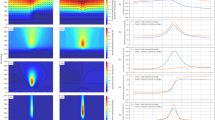Abstract
The Graz Ionospheric Flux Tube Simulations (GIFTS) has been improved. The improved GIFTS model was used to numerically investigate the energy particle precipitation on the distribution of electron density in the ionospheric cusp foot-point region under conditions of large plasma convection during magnetic storm. After including the effects of low energy incident particles, the ionospheric electron densities increase remarkably above altitude of ∼250 km, showing a peak at about 350 km. The percent enhancements of electron densities increase gradually with altitude, exceeding 60% near the upper boundary of the calculation. The calculated ionospheric F 2-peak was remarkably enhanced and lifted up by the incident low energy electrons.
Similar content being viewed by others
References
Zhu M H, Cao C, Wu J. Analyses of Ionospheric Properties over Zhongshan Station Antarctica [J]. Chinese J of Radio Sci, 1996, 11(1):96–101 (Ch).
Zhu M H, Cao C, Wu J. The Effects of Low Energy Electron Precipitation on the Ionosphere over Zhongshan Station, Antarctica [J]. Chinese J of Polar Res, 1998, 10(1): 31–36(Ch).
Shen C S, Zi M Y, Wang J S, et al. The Features of f 0 F2 at Zhongshan Station of Antarctica [J]. Chinese J of Polar Res, 2003, 15(3): 186–194(Ch).
Zhang B C, Liu R Y, Liu S L. Simulation Study on the Influences of the Precipitating Electrons on the Polar Ionosphere [J]. Chinese J of Geophys, 2001, 44(3): 311–319(Ch).
Liu Y C, Ma S Y, Cai H T, et al. The Background Ionospheric Profiles at Polar Cusp Latitudes-ESR Observations [J]. Chinese J of Polar Res, 2005, 17(3): 193–202(Ch).
Ma S Y, Cai H T, Liu H X, et al. Positive Storm Effects in the Dayside Polar Ionospheric F-Region Observed by EISCAT and ESR During the Magnetic Storm of 15 May 1997 [J]. Ann Geophys, 2002, 20: 1377–1384.
Kirchengast G. Theoretical Ionospheric Model and Its Use for TID Simulations [D]. Meteorol: University of Graz, 1992.
Kirchengast G, Hocke K, Schlegel K. Gravity Waves Determined by Modeling of Traveling Ionospheric Disturbances in Incolherent-Scatter Radar Measurements [J]. Radio Sci, 1995, 30: 1551–1567.
Kirchengast G, Hocke K, Schlegel K. The Gravity Wave-TID Relationship: Insight via Theoretical Model — EISCAT Data Comparison [J]. J Atmos Terr Phys, 1996, 58: 233–243.
Cai H T, Ma S Y, Kirchengast G. A Simulation Study of Ionization Depletion in the Auroral Ionospheric F-Region Cased by Strong Convection Electric Field [J]. Wuhan Univ J Nat Sci, 2001, 6(3): 680–686.
Spiro R W, Reiff P H, Maher L J. Precipitating Electron Energy Flux and Auroral Zone Conductance-An Empirical Model [J]. J Geophys Res, 1982, 87: 8215–8227.
Hardy D A, Gussenhoven M S, Raistrick R, et al. Statistical and Functional Representation of the Pattern of Auroral Energy Flux, Number Flux, and Conductivity [J]. J Geophys Res, 1987, 92: 12275–12294.
Meier R R, Strickland D J, Hecht J H, et al. Deducing Composition and Incident Electron Spectra from Ground-Based Auroral Optical Measurement [J]. J Geophys Res, 1989, 94(A10): 13541–13552.
Rees M H. Auroral Ionization and Excitation by Incident Energetic Electrons [J]. Planet Space Sci, 1963, 11(10): 1209–1218.
Lyons L R, Koskinen R H E J, Blake J B, et al. Chapter 3 — Processes Leading to Plasma Losses into the High-Latitude Atmosphere [J]. Space Sci Rev, 1999, 88: 85–135.
Author information
Authors and Affiliations
Corresponding author
Additional information
Foundation item: Supported by the National Natural Science Foundation of China(40404015, 40390150) and the Open Foundation of the Key Laboratory of Geospace Environment and Geodesy of Ministry of Education
Biography: CAI Hongtao(1976–), male, Associate professor, Ph.D., research direction: polar magnetosphere and ionosphere.
Rights and permissions
About this article
Cite this article
Cai, H., Ma, S. & Kirchengast, G. Numerical simulation of ionization enhancement in the topside ionosphere of cusp foot-point region caused by low energy particle precipitation. Wuhan Univ. J. Nat. Sci. 13, 185–190 (2008). https://doi.org/10.1007/s11859-008-0211-4
Received:
Published:
Issue Date:
DOI: https://doi.org/10.1007/s11859-008-0211-4
Key words
- magnetic storms
- particle precipitation
- cusp
- ionization enhancement
- ionospheric physical model
- numerical simulation




